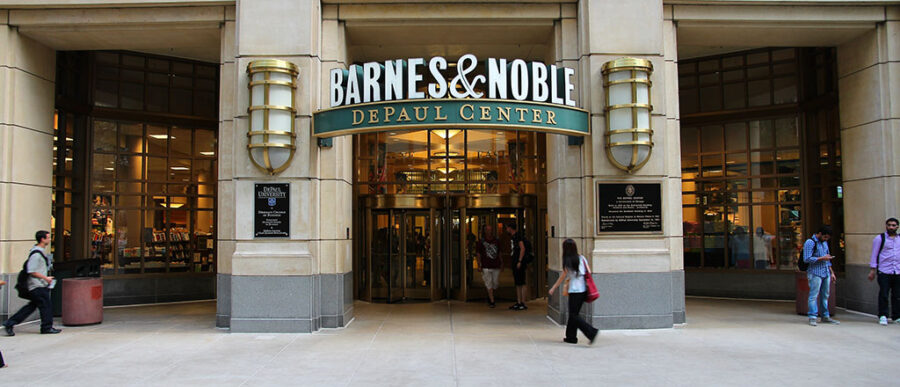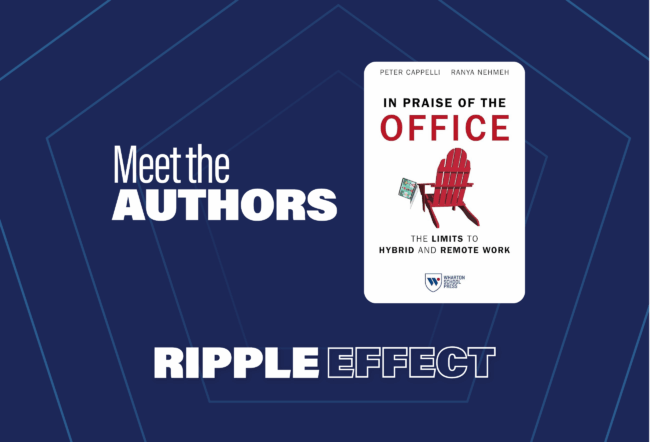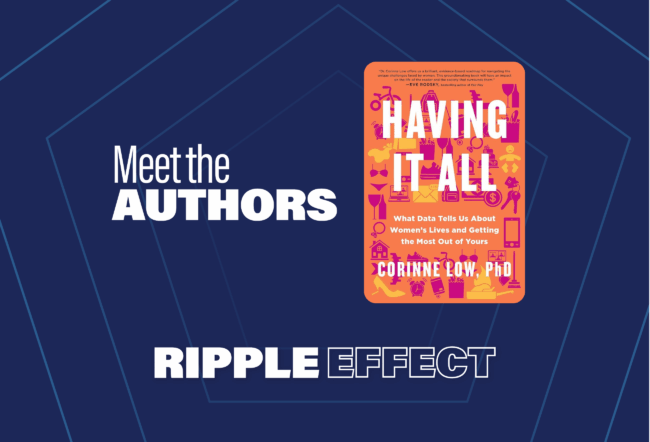The ups and downs of bookstore chain Barnes & Noble paint a tale as gripping as the plot of a bestselling potboiler: A Horatio Alger-type entrepreneur whose dad was a boxer and part-time taxicab driver drops out of college to build the biggest bookstore chain in the country. The success of Barnes & Noble even served as the backdrop for the Tom Hanks-Meg Ryan 1998 romantic comedy You’ve Got Mail, where a superstore chain offering book discounts kills the business of a beloved local bookshop.
In the Barnes & Noble story, the protagonist is modern-day founder Len Riggio, whom Wired magazine described in a 1999 article as “tempestuous, 5’7, wears an anachronism of a mustache, and spits out quick jagged sentences” in a New York outer-borough accent. Riggio believed that independent bookstores were too small to be efficient and customers had to wait weeks for special orders, so he went big in order to stock thousands more books. To make his big stores cozier, he installed sofas and coffee bars. But the expansion of his superstores led to many independent bookstore closings, and he became a sort of “publishing Antichrist,” according to Wired.
How times have changed. In an ironic plot twist worthy of a Jackie Collins novel, the disruptor has been disrupted. Since the 1990s, Amazon has been taking away sales from bookstores, including Barnes & Noble. And unlike Barnes & Noble, Amazon’s growing publishing business also seriously threatens the business of publishers. So publishers and bookshops have anointed a new Public Enemy No. 1. “The industry that looked on Barnes & Noble as a virus now treats Amazon like a pandemic,” wrote New York magazine back in 2013. “Now they’re on the side of Barnes & Noble, the last bastion of bricks and mortar.” This turning of the tables, it said, is a “close lesson in the ironies of capitalism.”
Today, Amazon commands around 72% of adult new book sales online and 49% of all new book sales by units, reported The Wall Street Journal. As Amazon was surging, sales at Barnes & Noble went the opposite direction. In fiscal 2018, total sales came to $3.66 billion, down by nearly $1 billion from 2014, according to a filing with the Securities and Exchange Commission. Comparable-store sales, a key retail metric, had fallen yearly over that period. Overall, net loss amounted to $125.5 million ($1.73 per share) last year, including a goodwill impairment charge of $133.6 million, compared with a loss of $47.3 million ($1.12 per share) in 2014.
“Barnes & Noble is pretty boxed in right now,” notes George Day, Wharton professor emeritus of marketing. “I’d like to see them survive, but they’re really being squeezed. They’re getting chewed up on the one hand by Amazon, and on the other, by libraries and independent bookstores” that have had a renaissance of sorts by enhancing their community engagement and offerings to adapt to the changing needs of the marketplace. “It’s a highly competitive market, and each is finding its own niche,” he adds. “That’s the challenge.”
“[Barnes & Noble is] getting chewed up on the one hand by Amazon, and on the other, by libraries and independent bookstores.” –George Day
But it’s not too late. “There is definitely a way forward for the chain,” according to Santiago Gallino, Wharton professor of operations, information and decisions. The company enjoys good brand recognition, and that is a “huge asset. The challenge is that the changes that need to happen are not small ones,” he adds. While Toys ‘R Us, Circuit City and Radio Shack also were good brands but went bust, Gallino points to the turnaround at Best Buy as an example that bricks-and-mortar can make it. “Coming in with new owners can help. You have a lot of legacy systems and legacy management — having new ownership can be a good signal,” he says. “It can convey the confidence that someone is investing money and trusting that this can be turned around.”
Deus Ex Machina?
On June 7, Barnes and Noble agreed to be acquired by U.K. hedge fund Elliott Advisors for $6.50 per share or about $475 million in cash. Including the assumption of debt, the deal is valued at $683 million. Now, the Journal is reporting that another interested buyer has emerged: Readerlink, a major book distributor serving non-book retailers such as Walmart and Target. Still more could be arriving: An investor group led by major shareholder Richard Schottenfeld said in a June 7 SEC filing that Barnes & Noble is “worth considerably more” than the current bid and urged its board to ease the way for other buyers.
If Elliott were to succeed in its buyout bid, it will be running the largest bookstore chains in both the U.S. and U.K., with its Waterstones bookshops. Barnes & Noble has 627 stores in all 50 states while Waterstones has 293 bookstores in the U.K., Ireland, The Netherlands and Belgium. Waterstones booked sales of 402 million pounds ($505 million) in fiscal 2018, which is quite a bit less than Barnes & Noble. Day sees challenges ahead: “British retailing is intensely competitive but it’s dealing with a smaller market, a more homogenous market, and the history of British [retail chains] succeeding in the U.S. … has been pretty poor.”
A daunting task may lie in wait for James Daunt, the CEO of Waterstones who also will run Barnes & Noble, but he has a plan. A former bookshop owner and avid reader, Daunt said in a recent interview with Publishers Weekly that Barnes & Noble needs investment, not further cost cuts. “The simple fact is that Barnes & Noble needs money: People want to shop in places that look modern clean, and inviting. The Barnes & Noble stores look tired and need a little botox,” he said. Daunt’s idea, which he implemented at Waterstones, is to give each branch manager more autonomy to cater to locals. “I think bookshops must have a personality,” he told The Guardian, a U.K. paper, in 2018.
Daunt aims to make each bookshop unique and get away from cookie-cutter stores. By doing so, he hopes to reinvigorate the chain one step at a time — there will be less pressure from Wall Street once Elliott takes the company private. “There are some people who come in with a 100-day plan, but I am not like that and this is not that kind of situation,” he told Publishers Weekly. “I am not marching into Barnes & Noble and saying, ‘Here is the answer.’ We are in a vocational trade and we make money by doing booksellery things. So that is what we will do. Nothing will change quickly. There may be the odd tough decision to make — hopefully not too many. I am looking forward to the challenge.”
It’s not an entirely novel idea. Barnes & Noble’s strategy was to make its stores like community centers and deliver a “much more experiential as opposed to transactional” atmosphere, notes Day. A decade ago, that might have been a “reasonable” goal. But two things make that tougher to do now. One was the decision to spin out its campus bookstore division in 2015 — Barnes & Noble Education Inc., which is a $2 billion business. “That is the one place with some potential for becoming a destination. The traffic is there. You could have curated events, bringing students and parents in,” Day says. “On many campuses, it is indeed a potential community center.”
The second is that Barnes & Noble’s size and scale — it grew in heft by acquiring B. Dalton and Borders bookstore chains — make it hard to foster the kind of intimate community center ambience it wanted. The chain’s average store size is 26,000 square feet and each carries anywhere from 19,000 to 143,000 titles. And then there’s the issue of finding staff for its more than 600 stores who are passionate about the community and know books well. All in all, “it’s hard for a corporation to be a community center,” Day notes. “In order … to monetize it, you’ve got to have a lot of scale, a lot of throughput and good systems, but that probably [means] you’re not an appealing place for book lovers.”
“[The company’s brand recognition] is a huge asset. The challenge is that the changes that need to happen are not small ones.” –Santiago Gallino
Meanwhile, consumers are finding alternatives to bookstores in their local libraries. According to Day, libraries already have a relationship with the community and over the years have established themselves as neighborhood centers with author events, workshops, ESL and job training classes and the like. They’re also stepping up digitally, loaning out ebooks and rolling out mobile apps. “Libraries have had to, in the last 10 years, rethink themselves and have done some amazingly creative things,” he says. That means “Barnes & Noble is effectively late to the party.”
Crossing Swords with Kindle
Another strategy that didn’t work well for Barnes & Noble is betting aggressively on its Nook e-reader to go up against Amazon’s Kindle. “They got a little bit of a late start, which I think hurt them,” according to Ray Wimer, professor of retail practice at Syracuse University, who spoke on the Knowledge at Wharton show on SiriusXM. In fiscal 2018, Nook sales fell to $111.5 million from $505.9 million in 2014, according to the company’s SEC filing. It was the worst performing business within Barnes & Noble.
Nook was kept “alive too long,” notes Katja Seim, Wharton professor of business economics and public policy. “With a network product like e-readers and ebooks, it seemed hard to imagine them being able to catch up with Kindle and Apple” with the iPad. Barnes & Noble, she adds, is bound to lose playing Amazon’s game. “It is more difficult to justify making the massive logistics investments Amazon has made in recent years to improve delivery times and reliability.” And as Amazon has added more products to sell, consumers see it as a one-stop shop and have bought more things on its website, including books.
Books are easy to buy online because the product is the same anywhere. So price and convenience become differentiators — Amazon’s strengths. “Books in particular are a category where customers are incredibly price sensitive,” notes Gallino. “It’s also a product where customer perception of risk of buying a book online is extremely low.” That’s not the same with, say, perfume, which the shopper would like to smell first, he says. “So when customers are searching for books online, they feel comfortable about buying online, and customers are also not particularly in a rush, unlike [when shopping for] diapers,” Gallino adds.
Over the years, this has been Barnes & Noble’s game plan: It implemented a multi-year strategy focused on reviving its core business, which suffered due to customer traffic declines, according to its SEC filing. To attract more people, the company has been improving its merchandising offerings, increasing promotional activities, narrowing product assortments, making navigation in the stores better, enhancing product discovery, adding in-store events, parsing the data from its membership program to get insights about the customer, as well as experimenting with smaller prototype stores.
It has had some success: Non-book sales (toys, games, café products and services, gifts and the like) grew. In the three quarters ended January 26, this business composed 31% of total revenue, up from 28% a year earlier. Meanwhile, sales of the company’s core media business (books, newsstand, movies and music) weakened, composing 67% of total revenue from 69% while digital dipped to 2% from 3%. All the while, Barnes & Noble has been cutting costs to protect its profits.
But its efforts, obviously, were not enough. “I just don’t think it has given customers [enough of] a reason to come into the store,” according to Barbara Kahn, Wharton marketing professor, who spoke on the radio show. If a shopper wants to get a cup of coffee or a meal, she or he won’t necessarily think of going to a Barnes & Noble to do so. Also, “you want to buy a book, it’s just easier to buy it online even if you want a physical book,” she says.
While Barnes & Noble also lets consumers buy products online for pickup in the store, Kahn and Wimer disagree on whether it is an effective strategy for books. Wimer thinks the service gives people another reason to go into the store, where they might buy more things. But Kahn believes that’s not much of an advantage with books, where people can just download an ebook. Or people can choose to wait for the book to be shipped to them. “It’s just not that hard to get it delivered,” Kahn says. “It’s very different from groceries or something that you really do need right away.”
“People don’t want to go into boring stores without sales associates.” –Barbara Kahn
The Way Forward?
Barnes & Noble should do what bookstores do best in ways that Amazon can’t match, like holding more author and community events, Kahn suggests. The chain could also experiment with having a “store within a store” to further drive up excitement, she added. What it shouldn’t do is lay off people to cut costs when sales fall, which retailers tend to do. It hurts the shopping experience and further damages sales, and then the retailer gets caught in a downward spiral that’s hard to reverse. “People don’t want to go into boring stores without sales associates,” Kahn adds.
Another thing Barnes & Noble could do is further expand its toy selection. “The huge opportunity in the U.S. now, with Toys ‘R’ Us going away, is in toys, especially educational toys,” Wimer notes. He also recommends partnering with another favorite kid’s brand, Lego, and perhaps even setting aside part of the store as a play area. Kahn adds that the bookstore chain could collaborate with schools to offer local events involving Legos. “That could be a really cool thing,” she says.
Barnes & Noble also could partner with publishers to offer books exclusively for a period of time, Kahn notes. It’s a strategy other retailers have executed to great effect. “You get a really big name [and title to promote, such as] Malcolm Gladwell’s newest book or Michael Lewis’ newest book,” she says. “For six months, you can’t buy it anywhere else but Barnes & Noble.” To create buzz during this exclusive period, the chain could hold community events and conduct other activities designed to support the book launches.
Independent bookstores have thrived by innovating. By offering a cozy spot for people to meet, eat, work and socialize, as well as stocking books geared to local tastes, they are finding their niches in an Amazon-driven retail world. From 2009 to 2015, the number of independents rose by 35% at a time when traditional retailers were folding, according to NPR. Meanwhile, ebook sales have plateaued to around 20% of book sales, Wimer says. “It seems like the consumer likes having a physical book.”
Daunt revived Waterstones with an independent-bookstore strategy and hopes to replicate his success at Barnes & Noble. For this task, the mild-mannered book lover has strong words. “Physical bookstores the world over face fearsome challenges from online and digital, a complex array of difficulties that for ease and some evident reason we lay at the door of Amazon,” he said in a statement. “Our purpose is to create, by investment and old fashioned bookselling skill, bookshops good enough to be a pleasure in their own right and to have no equal as a place in which to choose a book. We counter thereby Amazon’s siren call and defend the continued existence of real bookshops.”



